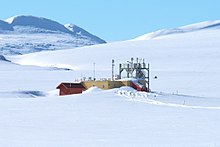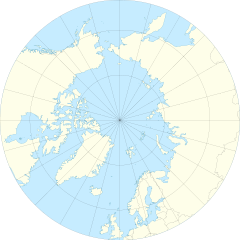Dr. Neil Trivett Global Atmosphere Watch Observatory

The observatory as it appeared on June 1, 2016
|
|
| Organization | Environment and Climate Change Canada |
|---|---|
| Location | Alert, Nunavut, Canada |
| Coordinates | 82°27′03″N 62°30′26″W / 82.45083°N 62.50722°WCoordinates: 82°27′03″N 62°30′26″W / 82.45083°N 62.50722°W |
| Altitude | 185 m |
| Established | August 29, 1986 |
| Website | www |
|
[]
|
|
The Dr. Neil Trivett Global Atmosphere Watch Observatory is an atmospheric baseline station operated by Environment and Climate Change Canada located at Alert, Nunavut, on the north-eastern tip of Ellesmere Island, about 800 km south of the geographic north pole.
The observatory is the northernmost of 31 Global Stations in an international network coordinated by the World Meteorological Organization (WMO) under its Global Atmosphere Watch (GAW) program to study the long-term effects of pollution on the atmospheric environment. Among these 31 stations, Alert is one of three greenhouse gas "intercomparison supersites", along with Mauna Loa in Hawaii and Cape Grim in Australia, which, due to their locations far from industrial activity, provide the international scientific community with a baseline record of atmospheric chemistry.
The observatory is located on a plateau about 6 km south of Canadian Forces Station (CFS) Alert, which is itself located on the shore of the Lincoln Sea, 15 kilometres from the mouth of the Nares Strait. The region is characterized by recent glacial activity, with still extant glaciers visible among the peaks of the United States Range approximately 40 kilometres to the west. The landscape immediately surrounding the observatory is undulating, marked by cliffs and crevasses and a number of small rivers which can become impassable during freshet.
To the south, the Winchester Hills are the dominant visible feature. A number of small freshwater lakes provide CFS Alert (and by extension, the observatory) with drinking water.
Due to its high latitude, the observatory experiences 24-hour daylight from the beginning of April to early September, and the sun remains below the horizon from mid-October to late February. The intermediate periods are marked by a slight diurnal cycle. The dark season is responsible for much of the unique atmospheric chemistry that occurs during polar sunrise. The lack of sunlight to act as a catalyst causes a buildup of pollution from industrial areas down south, and the polar vortex amplifies this effect by containing pollution within the high Arctic. During sunrise, this pollution is responsible for a phenomenon known as Arctic haze.
...
Wikipedia

